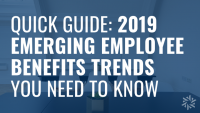According to a Gallup poll, one out of six full- and part-time working Americans are also a caregiver for a loved one. Usually, a caregiver is an unpaid individual who assists an elderly or disabled family member, relative or friend. The National Alliance for Caregiving and AARP estimate that 70 percent of working caregivers suffer work-related difficulties due to their multiple roles. Also, caregivers are forced to miss an average of 6.6 days of work annually because of their caregiving responsibilities. The annual cost of lost productivity due to caregiver absenteeism amounts to more than $25 billion.
As the baby-boomer generation continues to age, it is likely that younger employees will begin taking on additional caregiver responsibilities. With the generational shifts, caregiving benefits stand to become a top priority in health and benefits.
What are caregiver benefits?
Currently, caregiving benefits take many forms. Of the 129 employers surveyed by the NEBGH (Northeast Business Group on Health) and AARP (American Association of Retired Persons), the following policies are currently available to their workers:
Paid leave exclusively for caregiving—11 percent
Paid leave that can be used for parental leave or caregiving leave—22 percent
Paid family medical leave—29 percent
Sick, vacation or personal days to use for self-care or to care for another—81 percent
Family medical leave application guidance—77 percent
Flexible scheduling—57 percent
Employees can “donate” time to their co-workers—21 percent
As demonstrated by this data, the majority of employers surveyed permit employees to use their sick, vacation or personal days for caregiving, but few have leave or benefits programs designed specifically for caregivers.
Employers may feel the absence of caregiving benchmarks and best practices, a lack of financial resources and a lack of data to identify caregivers, as reasons why they struggle to become more caregiver-friendly.
How can my organization implement caregiving benefits?
One of the most common caregiving benefits is offering sick, vacation or personal days that can be used for self-care or to care for another. Start by reviewing these policies to consider updates that will help those in caregiving roles and possibly all your employees.
In addition, your organization could create a benefit program designed specifically for caregivers to give employees additional support in the form of extra time off or educational resources, such as free counseling, handouts and discount programs for at-home services.
Consider also implementing a flexible scheduling policy at your organization and train managers and supervisors on how they can support employees who are caregivers. An employee assistance program may also have specific help for caregivers, their families, and any other employees who may have concerns about caregiving. Keep in mind the following general best practices for developing specific caregiver policies:
Be aware of, and train managers about, the legal obligations that may impact decisions about treatment of workers with caregiving responsibilities. Those include federal employment statutes and regulations, such as the Americans with Disabilities Act of 1990, as amended; the Equal Pay Act of 1963, as amended; the Pregnancy Discrimination Act; Title VII of the Civil Rights Act of 1964, as amended; the Family and Medical Leave Act (FMLA); the Employee Retirement Income Security Act (ERISA), 42 U.S.C. §1983 and Executive Order 13152.
Develop, disseminate and enforce a strong EEO policy that clearly addresses the types of conduct that might constitute unlawful discrimination against caregivers based on characteristics protected by federal anti-discrimination laws.
Ensure that managers at all levels are aware of, and comply with, the organization’s work-life policies. In particular, front-line supervisors, middle management and other managers who regularly interact with employees or who are responsible for assignments, leave approval, schedules, promotions and other employment terms, conditions and benefits should be familiar with the organization’s work-life policies and supportive of employees who take advantage of available programs. You should regularly evaluate managers/supervisors on their willingness and effectiveness in assisting employees who have caregiving responsibilities to find areas for improvement and opportunities for recognition/incentive.
Respond to complaints of caregiver discrimination efficiently and effectively. Investigate complaints promptly and thoroughly. Take corrective action and implement corrective and preventive measures as necessary to resolve the situation and prevent problems from arising in the future.
Protect against retaliation. Provide clear and credible assurances that if employees make complaints or provide information related to complaints about the unfair treatment of caregivers, the employer will protect them from retaliation. Ensure that these anti-retaliation measures are enforced.
Implementing caregiving benefits has been a step taken by many employers across the country to help alleviate some of the stressors caregiving employees face. By offering caregiving benefits at your organization, you will not only establish a culture that is supportive of caregivers, but you will also be giving your employees the tools they need to effectively manage their dual responsibilities.
For more HR Know-How and benefit articles, check out our Benefit Resource Center. For guidance on crafting your total benefits package and how it can impact caregivers in your workplace, contact the experts at Austin Benefits Group today.



